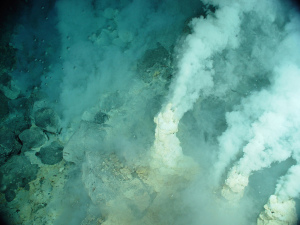Wellspring of Life: Hydrothermal vents power biology far beneath the waves
When we think of the Earth and its life-forms, we tend to think of life on the land. As land-dwelling animals, we perceive the best of the planet’s animal and plant variety, its most advanced species and interesting geomorphology as existing high and dry on its continents and islands. The oceans for most of our history were inaccessible depths, from which we drew fish to eat but gathered little scientific information with which to inspire our imaginations about their marine environments. But now that we can explore them with submersible and remote sensors and photograph them for the human world to enjoy, we are finding that these environments are just as active and diverse and their inhabitants just as magnificent as their land-based analogues.
All other vertebrates – that is, everything, including humans, with a backbone – have evolved from fish that at some point migrated onto the land. Not surprisingly given their 450 million-year history, we have identified more living varieties of fish than of any other vertebrate group – in excess thirty thousand – split into four classes as distinct from one another as birds are from amphibians. The evolutionary pathways that led to this diversity illustrate the great range of ecological niches available underwater. There are ramoras (‘shark-suckers’) whose ancestors’ fins evolved into sucker-pads and migrated onto their heads to help them latch onto bigger animals and eat the scraps of their meals. There are flat fish that spend much of their lives lying camouflaged on the sea floor, waiting to pounce on smaller fish. Oddly, they are asymmetric, with both eyes on the same side of the body. Fossil records show that one of their ancestors’ eyes gradually moved over the generations, with each incremental movement making it less vulnerable to damage from a rough sea floor or better-adapted to see approaching prey: a beautiful example of evolution in action. There are seahorses and puffer-fish, six-metre oarfish and 0.3-inch paedocypris, and fossils record yet more extreme extinct varieties.
Contrary to a perception gained from the flopping, asphyxiating specimens dredged up by fishermen, fish are far from unintelligent. They can be trained to move up or down, left or right, and experiments have shown that at least some are capable of producing an advanced three-dimensional map of their surroundings, measuring their closeness to the sea surface from the pressure in their internal gas bladders. Fish are our intellectual forebears, and, like us are capable of suffering. Problems of unnaturally rapid ocean warming and acidification brought on by climate change and the poisoning of the seas by poorly-disposed-of plastics should therefore be of no less concern than the habitat destruction and pollution faced by terrestrial animals.
Such complex ocean life is driven by a complex range of sub-marine environments. We now know that the bottom of the ocean is of a fundamentally different composition to the surface of the continents. Whilst terrestrial land is mostly ancient, with occasional upwellings of volcanic lava, the oceans are where the real action happens when it comes to tectonic plates. The basalt underlying the Atlantic ocean is brand new in geological terms, constantly being pulled up from below the Earth’s crust as the Americas and the Old World drift apart by 25mm per year. This creation is driven by the plates being subducted – pushed back under the crust – in the Pacific to form deep trenches. In such volcanically active regions as these, features such as deep-sea vents often arise, bringing the heat and complex chemistry necessary to sustain particularly productive biological communities. In fact, life on Earth might well have started in just such a place, as far away as one can get on Earth from the environment we usually think of when it comes to ‘life’ as we know it.
![Oceans of Life Wellspring of Life: Hydrothermal vents power biology far beneath the waves When we think of the Earth and its life-forms, we tend to think of […]](/wp-content/uploads/2014/11/Hydrothermal-vent-640x361.jpg)
